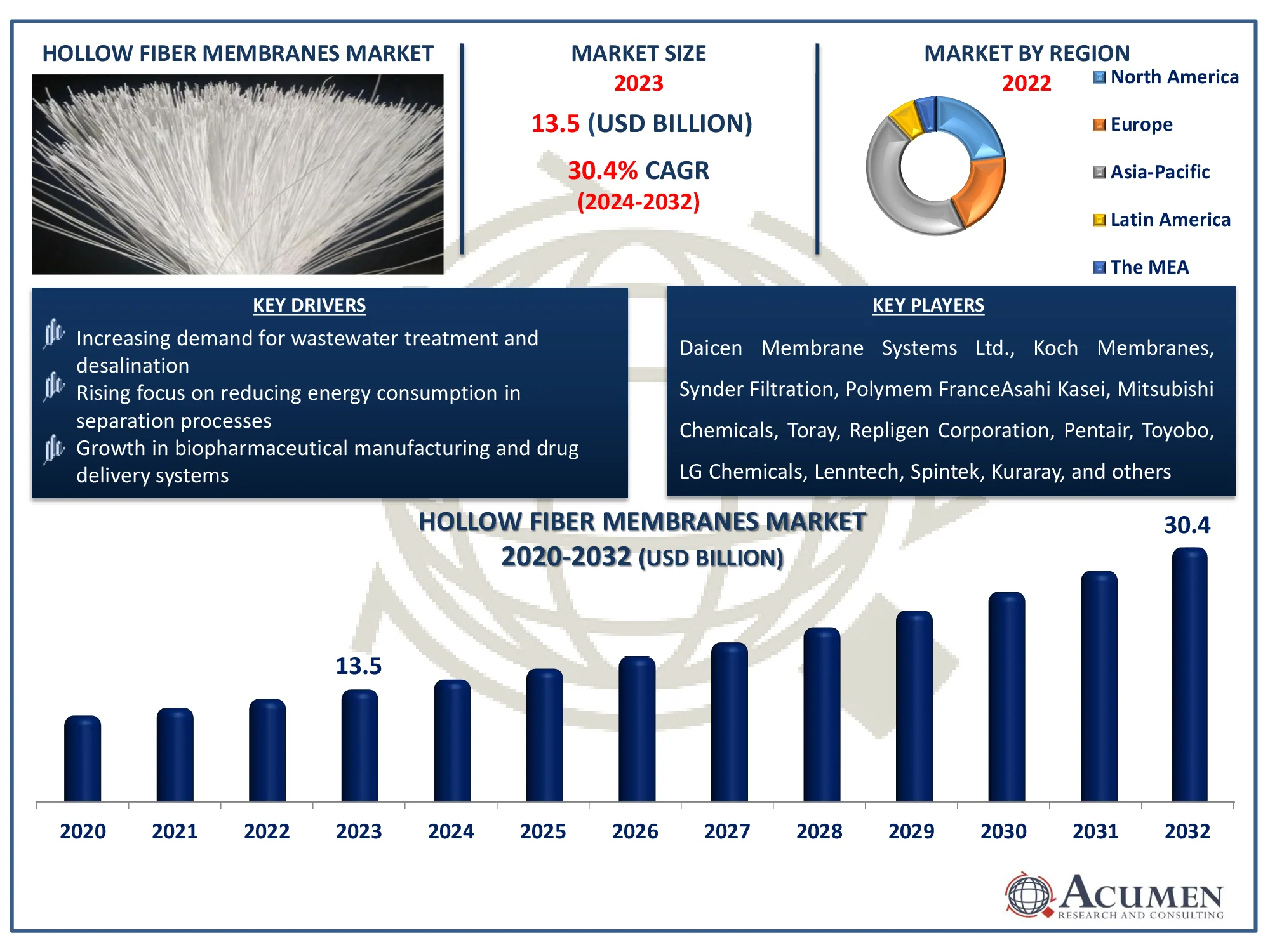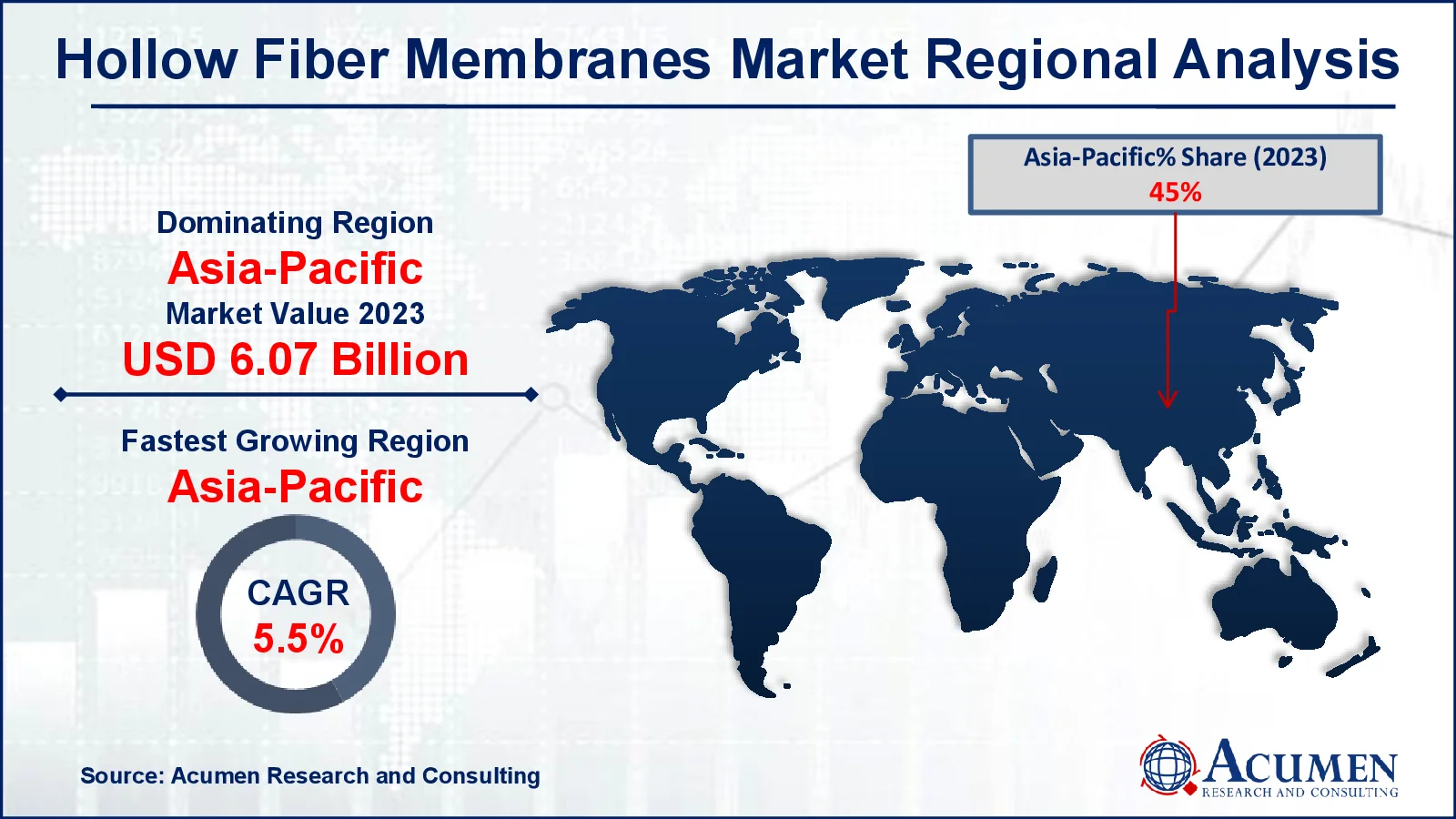Hollow Fiber Membranes Market | Acumen Research and Consulting
Hollow Fiber Membranes Market Size - Global Industry, Share, Analysis, Trends and Forecast 2024 - 2032
Published :
Report ID:
Pages :
Format : ![]()
The Global Hollow Fiber Membranes Market Size accounted for USD 13.5 Billion in 2023 and is estimated to achieve a market size of USD 30.4 Billion by 2032 growing at a CAGR of 9.5% from 2024 to 2032.
Hollow Fiber Membranes Market (By Filtration Type: Microfiltration, Ultrafiltration, and Reverse Osmosis; By Membrane Material: Polymer, and Ceramic; By End-User: Water & Waste Water Treatment, Food & Beverages, Biotechnology, and Pharmaceuticals & Chemicals; and By Region: North America, Europe, Asia-Pacific, Latin America and MEA)
Hollow Fiber Membranes Market Highlights
- Global hollow fiber membranes market revenue is poised to garner USD 30.4 billion by 2032 with a CAGR of 9.5% from 2024 to 2032
- Asia-Pacific hollow fiber membranes market value occupied around USD 6.07 billion in 2023
- Asia-Pacific hollow fiber membranes market growth will record a CAGR of more than 5.5% from 2024 to 2032
- Among filtration type, the microfiltration sub-segment generated significant market share in 2023
- Based on material, the polymer sub-segment generated notable market share in 2023
- Advancements in membrane technology improving efficiency and durability is the hollow fiber membranes market trend that fuels the industry demand

Hollow fiber membranes are cylindrical filtration membranes with a hollow core and dense outer walls, resulting in a large surface area for effective filtration and separation. These membranes are widely employed in a range of applications due to their adaptability and efficacy. They serve an important part in ultrafiltration, which removes pollutants from water and wastewater. They are commonly used in medicine for hemodialysis, which is the process of filtering waste from blood. Hollow fiber membranes are also used in gas separation systems and bioreactors for cell culture and fermentation. They are also used for sterilization and purification in desalination systems as well as the food and beverage industries. Their versatility across several industries emphasizes their usefulness in modern filtration methods.
Global Hollow Fiber Membranes Market Dynamics
Market Drivers
- Increasing demand for wastewater treatment and desalination
- Rising focus on reducing energy consumption in separation processes
- Growth in biopharmaceutical manufacturing and drug delivery systems
Market Restraints
- High initial investment and operational costs
- Membrane fouling leading to maintenance challenges
- Limited adoption in small-scale applications due to technical complexities
Market Opportunities
- Expanding applications in water reuse and recycling technologies
- Advancements in membrane material technologies to enhance performance
- Growing demand for sustainable filtration solutions in food and beverage industries
Hollow Fiber Membranes Market Report Coverage
| Market | Hollow Fiber Membranes Market |
| Hollow Fiber Membranes Market Size 2022 |
USD 13.5 Billion |
| Hollow Fiber Membranes Market Forecast 2032 | USD 30.4 Billion |
| Hollow Fiber Membranes Market CAGR During 2023 - 2032 | 9.5% |
| Hollow Fiber Membranes Market Analysis Period | 2020 - 2032 |
| Hollow Fiber Membranes Market Base Year |
2022 |
| Hollow Fiber Membranes Market Forecast Data | 2023 - 2032 |
| Segments Covered | By Filtration Type, By Membrane Material, By End-User, And By Geography |
| Regional Scope | North America, Europe, Asia Pacific, Latin America, and Middle East & Africa |
| Key Companies Profiled | Daicen Membrane Systems Ltd., Koch Membranes, Synder Filtration, Polymem, Asahi Kasei, Mitsubishi Chemicals, Toray, Repligen Corporation, Pentair, Toyobo, LG Chemicals, Lenntech, Spintek, Kuraray, Microdyn Nadir, Danaher Corporation, Evonik, and DowDuPont. |
| Report Coverage |
Market Trends, Drivers, Restraints, Competitive Analysis, Player Profiling, Covid-19 Analysis, Regulation Analysis |
Hollow Fiber Membranes Market Insights
The global hollow fiber membrane market is expected to develop due to increased demand in industries such as chemical processing, water and wastewater treatment, and pharmaceuticals. The revenue generation opportunity for manufacturers of hollow fiber membranes is predicted to increase as these products evolve and the role of microfiltration in industries grows. The growing demand for continuous water and wastewater treatment in both industrial and residential settings is eventually driving the hollow fiber membrane market forward.
The hollow fiber membrane market is predicted to expand due to rising demand in the biopharmaceutical industry. Hollow fiber membranes are increasingly being employed to support continuous manufacturing processes, which are becoming more prevalent in biopharmaceutical production. These membranes provide advantages in filtering, separation, and scalability, which align with the industry's emphasis on efficiency and quality. As biopharma moves toward continuous operations, the necessity for dependable filtering technologies such as hollow fiber membranes grows.
The increased emphasis on water reuse and recycling technologies creates considerable prospects for the hollow fiber membranes market. These membranes, which are known for their excellent filtering efficiency and versatility, are rapidly being used in wastewater treatment, desalination, and industrial water recovery applications. Their compact size and low energy consumption make them suitable for sustainable water management, in line with worldwide initiatives to alleviate water scarcity. As enterprises and municipalities implement circular water systems, demand for hollow fiber membranes is likely to increase, positioning the market for rapid expansion.
Hollow Fiber Membranes Market Segmentation
The worldwide market for hollow fiber membranes is split based on filtration type, material, end-user, and geography.
Hollow Fiber Membrane Market By Filtration Type
- Microfiltration
- Ultrafiltration
- Reverse Osmosis
According to the hollow fiber membranes industry analysis, microfiltration is the most used filtration type in the market because it can remove bigger particles and germs, making it excellent for water and wastewater treatment. It provides excellent efficiency and cost-effectiveness in applications such as drinking water purification and industrial processing. Furthermore, its relatively low-pressure requirements facilitate widespread implementation.
Hollow Fiber Membrane Market By Material
- Polymer
- Ceramic
The polymers continue their supremacy since they are the most extensively used materials. One of the distinguishing features of ceramic membranes is their remarkable resilience; nonetheless, they require maintenance and pretreatment, which limits their use. Ceramic membranes are generally employed in applications that demand high-pressure resistance when handling fluids such as acids and caustic solutions. On the other hand, polymers' high permeability qualities are increasing their application in industries. However, polymer dominates the worldwide hollow fiber membrane market, accounting notable market share.
Hollow Fiber Membrane Market By End-User
- Water & Waste Water Treatment
- Food & Beverages
- Biotechnology
- Pharmaceuticals & Chemicals
According to the hollow fiber membranes industry analysis, the water & wastewater treatment sector dominates the market, owing to the increased global emphasis on clean water and rigorous environmental regulations. These membranes are commonly utilized for desalination, filtration, and purifying procedures in municipal and industrial settings. Increasing urbanization and water shortages increase need for efficient filtration systems, establishing this sector as the key market leader.
Hollow Fiber Membranes Market Regional Outlook
North America
- U.S.
- Canada
Europe
- U.K.
- Germany
- France
- Spain
- Rest of Europe
Asia-Pacific
- India
- Japan
- China
- Australia
- South Korea
- Rest of Asia-Pacific
Latin America
- Brazil
- Mexico
- Rest of Latin America
The Middle East & Africa
- South Africa
- GCC Countries
- Rest of the Middle East & Africa (ME&A)

Hollow Fiber Membranes Market Regional Analysis
For several reasons, the Asia-Pacific region is expected to maintain its dominance by capturing potential market share in the global hollow fiber membrane market in the coming years. The increasing need for wastewater treatment and the necessity to meet industrial standards are positively affecting the adoption of hollow fiber membranes and driving the growth of the hollow fiber membranes market in the area. Freshwater scarcity in developing economies is driving up demand for hollow fiber membranes. Furthermore, increased awareness of the uses and importance of membrane systems across sectors is projected to drive the hollow fiber membrane market. Furthermore, the MEA area is likely to follow the APAC region in terms of growth opportunities, with a considerable CAGR over the forecast period driven by an increase in desalination plants, mainly in promising economies such as Saudi Arabia and the UAE.
Hollow Fiber Membranes Market Players
Some of the top hollow fiber membranes companies offered in our report include Daicen Membrane Systems Ltd., Koch Membranes, Synder Filtration, Polymem, Asahi Kasei, Mitsubishi Chemicals, Toray, Repligen Corporation, Pentair, Toyobo, LG Chemicals, Lenntech, Spintek, Kuraray, Microdyn Nadir, Danaher Corporation, Evonik, and DowDuPont.
Frequently Asked Questions
How big is the hollow fiber membranes market?
The hollow fiber membranes market size was valued at USD 13.5 billion in 2023.
What is the CAGR of the global hollow fiber membranes market from 2024 to 2032?
The CAGR of hollow fiber membranes is 9.5% during the analysis period of 2024 to 2032.
Which are the key players in the hollow fiber membranes market?
The key players operating in the global market are including Daicen Membrane Systems Ltd., Koch Membranes, Synder Filtration, PolymemAsahi Kasei, Mitsubishi Chemicals, Toray, Repligen Corporation, Pentair, Toyobo, LG Chemicals, Lenntech, Spintek, Kuraray, Microdyn Nadir, Danaher Corporation, Evonik, and DowDuPont.
Which region dominated the global hollow fiber membranes market share?
Asia-Pacific held the dominating position in hollow fiber membranes industry during the analysis period of 2024 to 2032.
Which region registered fastest CAGR from 2024 to 2032?
Asia Pacific region exhibited fastest growing CAGR for market of hollow fiber membranes during the analysis period of 2024 to 2032.
What are the current trends and dynamics in the global hollow fiber membranes industry?
The current trends and dynamics in the hollow fiber membranes industry include increasing demand for wastewater treatment and desalination, rising focus on reducing energy consumption in separation processes, and growth in biopharmaceutical manufacturing and drug delivery systems.
Which filtration type held the maximum share in 2023?
The microfiltration filtration type held the maximum share of the hollow fiber membranes industry.



